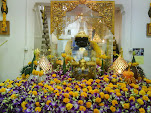My Sukhothai buddha statue at home
Sukhothai, meaning the ''Dawn of Happiness'' was the first free Thai city founded in 1238.
While there were other Thai Kingdoms (like Lanna, Phayao and Chiang Saen) at the same time, the establishment of the Kingdom of Sukhothai in 1238 is often considered the start of Thai history proper. Sukhothai gained independence from a declining Khmer Empire. Monuments in the city show influence from prior Khmer rule.It is still regarded by Thai historical tradition as the " first Thai Kingdom " , it began life as a chiefdom under the sway of the Khmer empire: the oldest monuments in the city were built in the Khmer style or else show clear Khmer influence.
While there were other Thai Kingdoms (like Lanna, Phayao and Chiang Saen) at the same time, the establishment of the Kingdom of Sukhothai in 1238 is often considered the start of Thai history proper. Sukhothai gained independence from a declining Khmer Empire. Monuments in the city show influence from prior Khmer rule.It is still regarded by Thai historical tradition as the " first Thai Kingdom " , it began life as a chiefdom under the sway of the Khmer empire: the oldest monuments in the city were built in the Khmer style or else show clear Khmer influence.
In 1378, the Ayutthaya King BorommarachaI subdued Sukhothai's frontier city of Chakangrao "Kamphaengphet", and henceforth Sukhothai became a tributary state of Ayutthaya. Sukhothai later attempted to break loose from Ayutthaya but with no real success, until in the 15th century it was incorporated into the Ayutthaya kingdom as a province. Many Buddhist chetiya were built at Sri Satchanalai. After the reign of king Ramkhamhaeng, Sukhothai was ruled successively by other two kings, namely Phraya Le Thai and Phraya Ngua Num Thom. During the time of these two kings the power of Sukhothai declined. Some former colonies of Sukhothai declared its independent. Sukhothai later regained its power during the time of Phraya Li Thai. The reign of king Li Thai are considered as the golden age of Sukhothai arts. Numerous important Buddha images and religious buildings were built not only at Sukhothai, but also at Pitsanulok an Khamphaeng Phet towns. The King also sent Buddhist pilgrims to many towns in order to enlarge the Buddhist followers. After the death of king Li Thai the power of Sukhothai declined again. Finally, Sukhothai became an outpost town under the ruling of the new powerful kingdom centered in the area further to the south, the Ayutthaya kingdom. The Kingdom of Sukhothai had important contacts with Sri Lanka. Thai monks travelled to Sri Lanka for further religious instruction, and Sri Lankan monks settled in Sukhothai. Sukhothai religious art was thus influenced by Sri Lankan art. The Buddha images of the Sukhothai era gained important disdinguishing characteristics from the images during the Khmer and Mon era.A flame appeared on top of the head of the Buddha. The head is covered with fine curled hair. The face is oval, with high curving eyebrows, a hooked nose, a downward gaze, and overall displays a gentle smiling expression.The body of the Buddha images displays broad shoulders and a small waist. Overall it can be said that the Buddha Images do not appear human, but display idealistic or superhuman characteristics.During the Sukhothai era, the four postures of the Buddha (sitting, standing, walking, reclining) were created. Buddha images of the Sukhothai era are subdivided in several groups.
Sitting Buddha images of the Sukhothai period most often display meditation posture, or the gesture of Subduing Mara. Walking Buddhas display the gesture of dispelling fear (Abhaya Mudra), or giving instruction (Vitarka Mudra).
Sitting Buddha images of the Sukhothai period most often display meditation posture, or the gesture of Subduing Mara. Walking Buddhas display the gesture of dispelling fear (Abhaya Mudra), or giving instruction (Vitarka Mudra).
胡



No comments:
Post a Comment